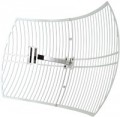Polarization
The type of polarization provided in the antenna.
Speaking very roughly and simply, a radio channel can be compared to a rope stretched from a transmitter to a receiver, and radio waves can be compared to the vibrations of this rope. Modern antennas for Wi-Fi and 3G are designed in such a way that these vibrations occur strictly in one plane — for example, up and down. Such waves are called polarized (more precisely, linearly polarized — other options are not relevant in this case). In the example above, the polarization is
vertical, but there is also horizontal polarization, when the oscillations occur from side to side.
The general rule for choosing a Wi-Fi / 3G antenna for this parameter is as follows: the polarization must match the polarization of the antenna (antennas) with which you plan to communicate. Otherwise, communication efficiency will drop significantly — up to the complete impossibility of work. However, the main option today is vertical polarization — it is used by the vast majority of cellular and Wi-Fi equipment. "Purely horizontal" antennas are practically not produced, the ability to work in horizontal polarization is usually provided as an option; to do this, the antenna must be rotated by 90 ° around the horizontal axis relative to the standard position. Theoretically, this possibility is available for any antenna, but in fact it is worth turning only those models for which this possibility is
...directly stated — they have the same horizontal and vertical HPBW (see below), and rotation does not affect the shape of the space covered.
Horizontal polarization can be useful when the air is loaded — it allows you to quite effectively separate the signal from other background (which is usually vertically polarized). However, this format of operation is rarely used, and, usually, for point-to-point connections, between two correspondingly rotated antennas.
There are a number of models that support the so-called dual polarization — when the signal is transmitted simultaneously in two polarization options. However, the need for such versatility is extremely rare, and it is expensive. Therefore, there are relatively few such antennas.HPBW / hor.
The effective angle spanned by the antenna in the horizontal plane.
Any antenna that is not omnidirectional radiates a signal in the form of a "beam", and unevenly: the power is highest in the middle of this beam and weakens as it moves towards the edges. The boundaries of HBPW are two opposite lines, on which the signal power is attenuated to half of the maximum. In other words, HBPW is a sector (in this case, horizontally) within which the signal from the antenna will not weaken by more than half and it will maintain acceptable performance.
Other things being equal, a more widely directional antenna will be more convenient in aiming at a target, and also more effective in difficult signal propagation conditions (for example, in dense buildings where it can come from different directions). A narrower focus, in turn, has a positive effect on the gain and, accordingly, the “range”.
HPBW / vert.
The effective angle of coverage of the antenna in the vertical plane, technically — the angle within which the signal power will be at least 50% of the maximum.
For details about the meaning of this parameter, see "HPBW / hor." higher. Here we note that if the antenna is not tilted, then the middle of the covered sector (that is, the line where the signal is most powerful) runs horizontally. Therefore, if another device to be contacted is above or below the antenna, the latter will have to be tilted for maximum communication efficiency. However, absolutely accurate guidance may be required only when receiving a very weak signal on a narrowly directed antenna — in other cases, hitting the HPBW itself is quite enough.
Max. power
The highest power that it makes sense to bring to the antenna input. Theoretically, this parameter affects the compatibility with the transmitter, but the average user rarely needs this information. So, even in the most “delicate” short-range Wi-Fi antennas, this limitation is 1 W, while the power of consumer routers in many countries is legally limited to only 100 mW — a license is required for a more powerful transmitter. So paying attention to the maximum input power is usually for those who work with specialized equipment — for example, WISP access points.
Gain
The signal gain provided by the antenna.
In this case, we mean the gain relative to an perfect isotropic radiator — an antenna that uniformly radiates a radio signal in all directions in the form of spherical waves. Such amplification is carried out by narrowing the flow of radio waves, roughly speaking, by increasing their concentration in space (even omnidirectional antennas emit waves not in the form of a sphere, but in the form of a disk). In this case, the coefficient is measured by the maximum power, which is achieved in the centre of the radiation pattern. Note also that the decibel is used to denote this parameter (more precisely, dBi, decibel relative to the isotrope). This is a non-linear unit: for example, a difference of 3 dB corresponds to a difference of approximately 2 times, 10 dB — 10 times, 20 dB — 100 times, etc. There are tables and calculators that allow you to convert decibels to times.
All this means that the gain is a rather specific parameter, and when choosing its optimal value, consultation with special sources or a professional communications operator may be required. However, this is true primarily for specific situations — for example, installing a 3G antenna in a private house a few kilometers from the base station. The general rule is this:
an increase in the gain has a positive effect on the communication range, however, it makes the antenna more susceptible to interference and, usuall
...y, affects its dimensions and weight.
